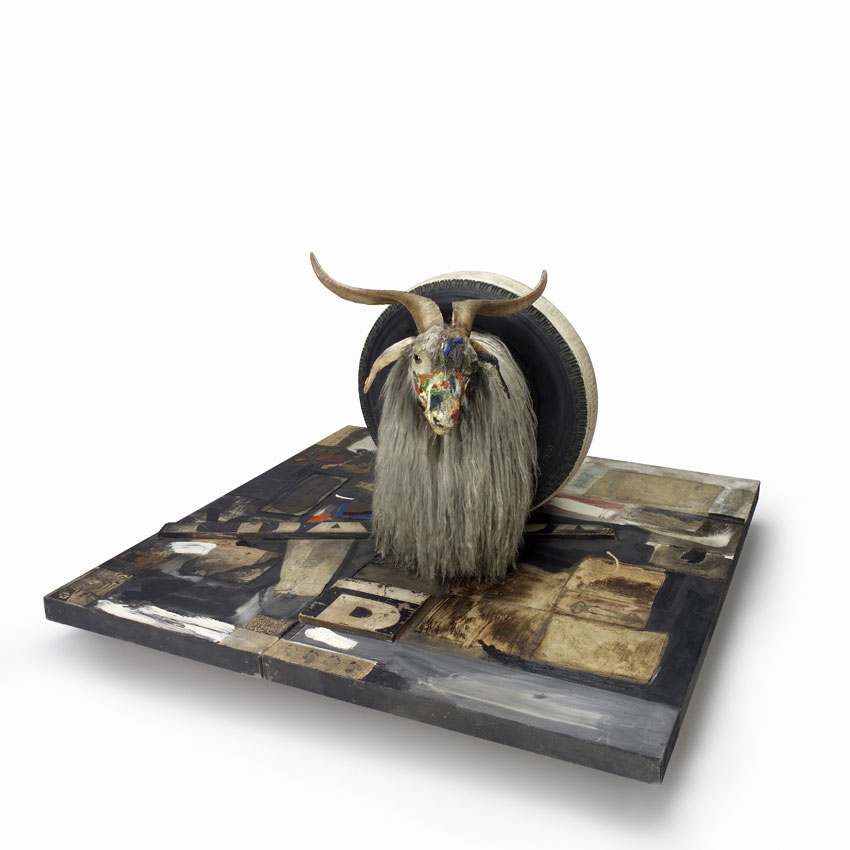Tate Modern, London, 1 December – 2 April 2017
Few artistic careers are more front-loaded than that of Robert Rauschenberg, so it’s no fault of the curators that this chronological retrospective, the first since the artist’s death in 2008, feels like an explosion, followed by a gently diminishing reverberation. The period covered in the first few rooms, starting from the artist’s student work at Black Mountain College in North Carolina during the late 1940s, through to his monochrome paintings, photography, found-object sculptures, combines and transfer drawings, is surely one of the most fecund in the history of art. The combines, his painting/ sculpture/found-object hybrids starting from the mid-1950s, are both a culmination of ideas born in Black Mountain’s interdisciplinary syllabus and a ground note for the rest of his career. They’re his Cubism, and – as for Pablo Picasso – they represent a short-lived creative surge, born of a collaborative spirit, whose implications were so transformative that it took the rest of a lifetime to extrapolate their full potential. Monogram (1955–9), the one with the goat, is an emblematic example, cramming in allusion – abstract-expressionist slathers of paint, collaged images, fragments of signage, a painted tyre, the heel of a shoe – whose frenetic registers can still be discerned in the final rooms of work made during the 1980s and 90s. Rauschenberg’s combines fired questions at then-dominant abstract-expressionist painting: could a painting be made against the clock (and include that clock, as in First Time Painting, 1961)? Could a painting contain other people’s paintings? Could a painting include a T-shirt, a parachute, a stuffed chicken, a handkerchief, a suitcase, a quilt? The answer to everything is yes. Rauschenberg’s answer to everything is always yes.
That the Tate show lacks some important works from this period (such as Rebus, 1955, which will appear in the MoMA iteration later this year, a large collage of dribbled paint and found material, including a sketch by Cy Twombly) undersells the centrality of the combines to Rauschenberg’s work as a whole. An evenhanded hang, giving equivalent space to later, less significant moments, somewhat dampens their force. What does resonate is a sureness of aesthetic that is absolutely a product of his education with Josef Albers at Black Mountain. Albers’s Bauhaus belief in the primacy of design is never far from Rauschenberg’s work, in which a kind of visual perfect-pitch rules even the most trash-filled composition. The list of materials used in a work like Charlene (1954), for instance – newspaper, oil paint, T-shirt, umbrella, mirror, electric light and more – implies chaotic abandon, yet every element is made to serve a pattern of related shapes. The detritus such works are composed of becomes a means to parlay their way into the ‘gap between art and life’ in which he claimed his works operated. Later, when his designer’s sensibility superseded the antic collagist, Rauschenberg’s work became hermetic, merely ‘nice’. His early 1960s silkscreens were made contemporaneously with Andy Warhol’s, but lack the latter’s willingness to second-guess his own instinct for snappy design. It’s telling that after winning the international painting prize at the 1964 Venice Biennale for the Retroactive works, he asked a friend to burn the remaining examples left back in the studio. That insatiability makes for an exhibition full of exhilarating switchbacks. Each series – like the sewn fabric Jammers (1975–6) or the scrap metal Gluts (1986–9; 1991–4) – exhausts the artist’s interest in a material idea, like an itch being scratched.
Almost every work is the result of a collaboration of some kind, from John Cage driving his Model A Ford over 20 sheets of paper for Automobile Tire Print (1953), to Merce Cunningham devising dance to interact with the combine Minutiae (1954), to Rauschenberg’s experiments with engineers and scientists, like the sound-operated Mud Muse (1968–71) and the Experiments in Art and Technology group formed in 1967. Making art into a social activity was Rauschenberg’s exit strategy from the sealed studio practice of the Abstract Expressionists. Even his Erased de Kooning Drawing (1953), ostensibly a straightforward Oedipal statement – a new generation literally obliterating its predecessor – is a collaboration: the erasing hand is, after all, the drawing hand’s negative twin. For Rauschenberg, art was a means of talking to strangers. And yet, as this endlessly absorbing exhibition proves, the collaborative instinct that threaded through his entire career was never allowed to overwhelm his own slyly refined sensibility. Everything he touched turned into himself.
From the March 2017 issue of ArtReview
